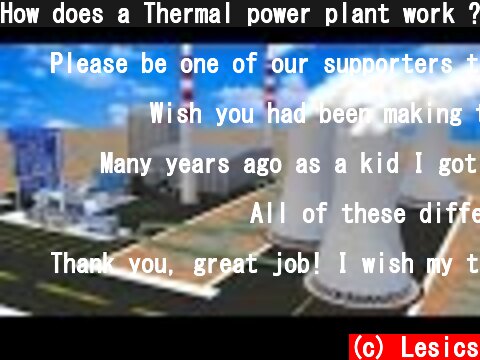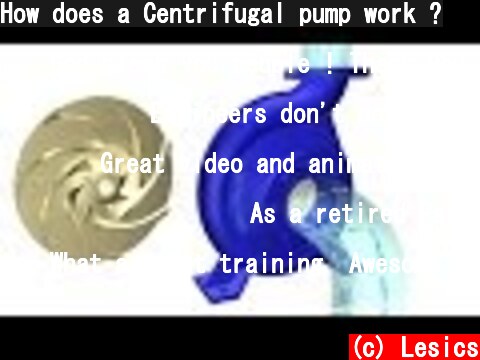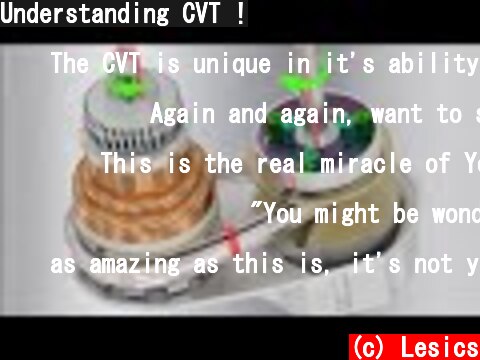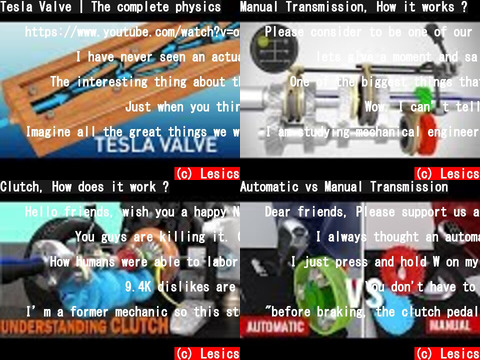How does a Thermal power plant work ?

(c) Lesics Help us to make future videos for you. Make LE’s efforts sustainable. Please support us at Patreon.com …
Please be one of our supporters today https://www.patreon.com/LearnEngineering , I will be so grateful.
Wish you had been making these when I was in school! It’s great to think about how many students you’re helping get into engineering though, very good work!
Many years ago as a kid I got to go around a coal fired power station, it was probably one of the best days out I’ve ever had. Shame they don’t see to do visits much any more. It’s amazing to see the engineering marvels that we’ve come up with. Great video BTW.
All of these different conversion points, compression points, efficiency amplifiers, et cetera, all working in unison is just beautiful. Many years of hard work and experimentation gives you this awesome symphony of science and engineering. This channel has helped me understand a plethora of different engineering methods greatlyLove this channel.
Thank you, great job! I wish my thermo professor showed me something similar to this.
I love you guys! I’ve recently started working at a CHP plant, and your vids are so helpful to grasp exactly how it works, since I in real life rarely can see what everything looks like inside. <3
Excellent animation. Top class.Wish we had such videos during our college days.Thanks a lot and God Bless you.
Good video. The energy efficiency of 20~25% in thermal power plant increases to 40~45% through the engineering process of Super heating, Re-heating, and Feed water heating
Ahh, the good ol’ Rankine cycle. I’ve studied the theory but haven’t really had the chance to visualize the actual, real world method. Great video as always!
this was just great…thank u for working so hard so that a bunch of engineers can have a far better understanding 🙂
A perfect study for learners. Helpful video Thank you sir ❤❤
like always, very helpful and interesting. the explanation is so clear and simple that easily could be understood. thank you very much for your informative videos. remarkable, excellent, fascinating.
May I just ask, what software do you use in making those animations of the powerplant?Thank you .
I watch this video 5 times to understand this process Literally amazing content
Perfect work! really amazing demo. Can you make explaining videos of how gravitational power plants work?
As the Plant Manager of a 1200 MW coal powered plant in the Midwest, I applaud your clear and concise explanation of the basic operations of a generic power unit. Well done! BTW, I also hold three engineering degrees: BS in Chem E, MS in ME, and MS in NAME. To those of you still in academia: never stop learning!!
Best explained video for engineers 👍👍Each and every component is covered too good ..
Great work. Excellent visuals, animations and narration to explain the different components of a thermal power plant. As a professional in this industry for over 25 years I would highly recommend this video for its content for those wishing to learn the basics of thermal power plants. I encourage you to expand this further to explain the nuances of each of the components in the future episodes. I am willing to provide my help if you need towards this effort.
It really helped me to get a clear concept of the basic mechanism . Thanks <3
Amazingly explained.. really understood every point and over all working of the plant😍.. thank you
Diesel Engine, How it works ?

(c) Lesics Help us to make future videos for you. Make LE’s efforts sustainable. Please support us at Patreon.com …
I came about this video by accident, and I was so impressed that I subscribed – very well explained and the animations are brilliant. Thanks to YouTube – the greatest learning revolution in the part few thousand years. There is no limit to what you can learn, if you put your mind to it.
Simple and clear explanation! Thank you.
humanity has finally reached the tipping point, the point where modern videos exceed the clarity and quality of content of 1940’s videos.
If most teachers were as good at explaining their subjects we wouldn’t dream of becoming whatever we want to be, we would actually achieve anything we wanted to.
6 minutes of my life i will never forget. i love this
You have some of the best videos I’ve ever seen regarding the topic of engines.Thank you very much for your effort!
Simple, Informative, and Clear. Good video! I wondered how a diesel engine works differently from petrol and came away with exactly that knowledge.
Had two professors at my uni trying to explain this to me.I can say you are better than them in every way, why are they even getting paid!!Thank you mate 🙂
Thanks for this clearly explained process. The other day when out walking the dog I found a diesel glo-plug out on the road. I was quite surprised to find one as you can see by the threads that itwould be quite well fixed into the engine head, as a result of finding it I was curious to see how they worked.This is the 1st time I’ve seen how the diesel process works and I noticed that when the upstroke gets to the top there is bound to be some residue left behind which then mixes with the new intake of the airfuel mixture.Wouldn’t you get a more efficient and purer fuel mix if you could expel all the old burnt fuel on the upstrokeexpulsion or am I talking a load of bollox and it makes no difference to the airfuel mixture ratio?
I’ve watched a few different videos, and I have to say you guys set these videos up very nicely and inform people very well with them.
5:56 the intake and exhaust cams are labeled backwards..Other than that, i love the videos, i’m very mechanically inclined, and these videos help me explain how things work to others! found this channel the other day, and so far i love every video i’ve watched, i even subscribed.. Thanks, Keep it up!�
This was a genuinely very good simple explanation I wish they got a little more into all the other machinery involved but still very much appreciated this video explanation 🙂
Excelente vídeo! Parabéns! 🇧🇷
This moment when you realize 4 cylinders are because of the 4 strokes and to offer power continuously. I feel illuminated.
Simply amazing, would recommend to anyone who wants to know the basics of diesel engines.
That was a really good explanation! I have a question. Can you tell me how is the power frequency maintained in a motorcycle with a single cylinder?
That was awesome.. I always thinking y do they use 4 cylinders. U cleared my doubts by simple explanation.. Thankss
Diesel engines operate at a compression ratio of 20:1 so 20 parts air to 1 part diesel fuel. The typical car operates at a compression ratio of around 9:1. Diesel engines don’t have spark plugs or produce vacuum like gas engines do.
Very good animation and simple to understand. Only now I really understand how the diesel engine works although I have been around them all the while. Thank you.
You forgot to mention the origin of the engine’s namesake. It is invented by a German mechanical engineer, Dr. Rudolph Diesel in 1892. He described it as a “compression ignition heat engine”. With the “diesel” engine named after him, his legacy lives on! 🇩🇪 ☝️.
How does your AIR CONDITIONER work?

(c) Lesics Sign up for your free Danfoss Learning account – http://bit.ly/DanfossLearningNow . Danfoss Learning is a free online training and …
Hello friends, Please check out http://bit.ly/DanfossLearningNow . This video would not have been possible without the support of Danfoss.
In my place this is very hot summer now. I am watching AC videos to get the feeling of having an AC. I am poor.
To understand how an AC works , one needs to understand the thermodynamic phenomena that occur : 1.Heat travels from HOT to COLD naturally.2.Boiling point of a liquid depends on both temperature and surrounding pressure. Water boils at 100 degr C / 1 bar atm pressure. If you lower the atm pressure below 1 bar, it will boil at less than 100 degr C.3.When a liquid ABSORBS heat it EVAPORATES. When vapor releases heat, it CONDENSES4.If a liquid is compressed, the pressure increases, temperature increases while volume decreases.So , when the refrigerant (liquid+vapor) gets into the evaporator (inside the house ) , it absorbs the heat from that room , hence , it evaporates . Now, in order for condensation to occur in the Condenser(outside the house), the now vapor refrigerant(hot) needs to be hotter than the outside air so that to give away the heat (see point 1 and 3 from above) and condense (become liquid again). For this to happen, the compressor compresses the vapor refrigerant thus increasing its temperature (see point 4 ) . When the compressed vapor refrigerant enters the condenser , it releases some of the heat into the surrounding air which has a lower temperature ( see point 1 ), and transforming into a liquid ( condensation ) . The liquid now passes through an expansion valve ,where its pressure is reduced and the liquid begins to boil (SOME vapors form) thus releasing some of its energy (heat) becoming even colder.Now we have a mix of cold liquid+vapor ready to repeat the cycle .
It’s still all magic as far as I’m concerned.
I am glad there are humans smarter than me who invented this technology and by doing so made all of our lives better.
The only thing you need to know is, there is no such a thing as “cold energy”. Cold is simply the lack of heat. So if you want to know the simple way how your AC works. It doesnt generate cold but simply transfer the heat inside your room to outside. Now with the lack of heat in your room, it will naturaly feel “cold” .
Much Appreciated. It actually makes so much sense how everything comes together. Wonderful piece of engineering!
Learned more than my 4 years course in Mechanical Engineering.
Today I am feeling a special respect to my air conditioner
Best job i’ve seen of explaining in clear and concise terms the principles of operation of a mechanism that bewilders most people, even the otherwise “mechanically inclined” among us. the awesome cutaway views of components in operation really reinforced the narrative as well. thanks for sharing this!
I love how you colour coded the coil lines to show when and where the temperature changes occur. Thank you for this educational video.
Fabulously explained! I had only learned about the principles of Thermodynamics but never knew how the AC actually worked. Thank you!
Great video. At some point you may lose the line of reasoning and the physics implied (as each part demands proper assessment) and you end up looking that some device is important because “it does some stuff that helps with other stuff” but you can always get back and tackle each segment or delve deeper into the mentioned concepts.
Truly informative and the description of the procedures is pretty detailed. This is exactly how courseware at the schools should be designed too. There’s no better knowledge than one that passes unhindered through yr eyes and ears, right into yr brain and stays there nicely.
After years of research, I finally found a tutorial that teaches properly the operation principle of an expansion valve. Thank you so much for sharing!!!! Regards from the Republic of Panama.
This explanation is awesome! However, I’m still curious about how does a dehumidifier mode on air conditioners work? I understand that the cool refrigerant both cools the air and condensates water from the air, but I don’t understand how can there be a separate DRY mode on ACs. Will the AC in DRY mode actually pull the air over the warmer coils (after the cold ones), thus collecting the condensed water on cool coils but not cooling the air since it goes over the warm coils as well? Or are DRY and COOL mode on ACs essentially the same?
I’m a Chemical Engineering student in Brazil and I love so much your videos and your passion of teaching and discovering ways of showing us how science works. I’m using Ansys to simulate fluid mechanics and your work inspired me
Brilliantly explained and animated! Thank you for making and sharing this.
You just made me feel i don’t deserve Air conditioners.
Saw this mid-study for my thermodynamics exam, this is definitely a helpful example of the 4 phase energy-transfer diagram and pV diagram.
How does a Centrifugal pump work ?

(c) Lesics Help us to make future videos for you. Make LE’s efforts sustainable. Please support us at Patreon.com …
God bless you people ! Thank you so much for such easy , comprehensive, clear and schematic videos.
Engineers don’t need articles. Great video. I feel very informed.
Great video and animation! Such a good cause to help with visual education in such difficult subjects.
As a retired Pattern Maker of 41 years, I Totally approve of this video. Thanks for posting.
What a great training. Awesome images and great explanations.
Fluid mechanics was probably one of the most complicated courses I’ve learned in University 😭
Excellent, informative and concise video! Thanks for posting it!
His hard work is really an inspiration.Keep working hard
Laterally I found you one of the best teacher in my life and helps me alot in learning engineering practically
I am interested in learning more about these, and my first question would probable be how would your create a hand-powered version? Like a pitcher pump, but with the design of a centrifugal one.
What software is used to create these animations? You should include that in the descriptions of the videos. And keep up the great work!
me encantar�a una versi�n en espa�ol :), pero igual es muy interesante gracias :3
Respected sir, I am happy to say that your videos really helpful during my study. I am requesting you that will you try to describe the animated video for Mumbai’s local trains engine? I want to study that how an engine works in this train.I hope you will try to teaching the video to me.Thanking you!….
a very helpful video, I just pulled apart my pump for maintenence and found this informative. thanks.
What software is used to create these animations? You should include that in the descriptions of the videos. And keep up the great work!
Thank you. This was the most helpful video on centrifugal pumps I found on YouTube 🙏🙏
nice video, please also include troubleshooting of the equipment in your video that will surely help. Thanks
Very informative and useful, thanks 😊😊
can you tell me in which software i can make animation like this for flowing water for my reciprocating pump?
This really helps. Thank you so much! 🙂
Understanding CVT !

(c) Lesics Help us to make future videos for you. Make LE’s efforts sustainable. Please support us at Patreon.com …
The CVT is unique in it’s ability to convert the power output of the engine into debilitating sadness.
Again and again, want to say thanks to the people who make educational videos like these.
This is the real miracle of YouTube. Learning this kind of things in such a cool way.
“You might be wondering how a reverse gear is even possible with this mechanism.”damn right i was
as amazing as this is, it’s not yet been proven in the real world, they break down too often and cost way too much to repair. If i ever get one i will wait a few more years before the bugs are worked out but for now i’m sticking with my manual 5 speed. 185K and still going strong.
As much as I don’t care to drive CVT driven cars, this is genius.
Here’s what I have learned about cvt after driving one for 9 years. On the whole, it works great. I really never feel it shift. If I drive carefully, I can keep the rpm’s pretty constant while speed increases. There’s one thing I don’t like about it. Contrary to the advertisement, it doesn’t get the same mileage as a stick shift. The figures they give you are only on level ground with the engine and transmission fully warmed up, which takes 10 to 15 minutes of driving. In the winter in Wisconsin, maybe longer. I would see my range go from 450 miles on a tank in the summer to 350 miles in the winter. My previous car with a 5 speed shifter had nowhere near that kind of drop in efficiency in the winter. But all in all, it is still my favored transmission.
I enjoyed your presentation, even though I already knew how they work. The CVT is an interesting concept, but I still have reservations — perhaps outdated — about its longevity, compared to a more conventional planetary gear automatic.
I remember watching a repair training video on CVTs once. First thing they did was go over a brief history of it. Originally, the mechanism was constructed and used, in the late 1800’s for newspaper print machines. I was thinking to myself, over 100 years, and they still can’t get it to work right in cars. What a surprise.
Forgot to mention that CVT offers the most acceleration of any transmission for the same engine. Also, you could conceivably design a turbocharged engine with extreme turbo lag for the sole purpose of being coupled with a CVT. The turbo lag is irrelevant because the CVT will always keep the engine in the power band, no matter how small.
Wow! As someone who went to automotive school and learned all about the traditional automotive transmission before this was a thing. I learned a lot in this video. In fact, this style transmission seems to be a lot simpler to understand once taken apart than a traditional transmission. Now, I just need a comprehensive explanation of how the Koenigsegg drivetrain works… without a transmission.
What this video failed to explain is that when a CVT unit fails, it will cost about 3-4 times as much as it cost to repair a conventional transmission.
CVT transmission is there since a long time and used in different motorized vehicles such as snowmobiles and they used for a long time it’s just now becoming huge in car industry and for sure it’s improved since then . I have a toyota with a CVT in it and it have over 100k miles with no issues . And as all the other things in car industry that came new by time you won’t notice it same like the electric power steering that all car have and no one talks about it
What is more interesting is that the Toyota Prius is not a CVT type transmission as commonly thought. The gas engine and both electric motors are always directly connected to the wheels and to each other at all times through a simple sun gear arrangement. One of the electric motor determines how much power is being directed to what and what direction forward or reverse). The Prius is always in gear at all times, there is no torque converter or clutch to disconnect the gas motor or electric motors from the drive wheels (There actually is a clutch but it is always engaged at all times, it is not controlled, its only purpose is to absorb drive train shock). The Prius is always in the same gear, the same gear ratio at all times. there is no reverse gear. The gas engine can start when the car is moving forward or moving backwards. Basically the sun gear transmission is directing gas engine power to the wheel or generator or both, how much power is directed to the wheels by the gas engine and or electric drive motor determines the speed your going to travel at while moving forward or moving backwards, again no gear changes or gear ratio changes ever, its always in the same gear at all times, always 100% engaged, even when parked or in neutral.
Its amazing how taking simple concepts of the machine and turn into precision instruments to transfer power more efficiently.
would love to see a dual clutch transmission video from you guys, your videos are great 🙂
I worked for Link Belt making single ratio industrial planetary gear boxes for 30 years, they are very strong and rarely fail, usually when they are run with no oil.
If torque wasn’t an issue for the belt, this would be amazing in supercars: Imagine something like a Koenigsegg one:1 with a max power output of 1,360hp and a max torque of 1,371Nm at 6,000rpm.With a CVT that could handle it, this car could accelerate at 6,000rom constantly, meaning the full 1,371Nm of torque all the time (until it is on the highest ratio, obviously).I imagine that as pretty awesome.
when that steel belt breaks , those small steel particles travel through out the transmission , usually in total destruction with little or no chance of a rebuild.
After years of driving standards, I wasn’t sure about moving to a CVT, but my Corolla SE 2021 has the Aisin Dynamic Force CVT, it’s awesome on the highway, great pickup, smooth as silk, and it sounds great too, in Canadian winter and summer. You don’t hear it all at any speed. So the exhaust has this low, basso rumble at up to 60 km/h, which I think is due to the resonator being right under and to the right of the driver, and then it’s very quiet at high speed. Makes the car sound like a little Lexus from the inside. It’s also got a single launch gear so that it has good pickup from stopping, then power is seamlessly transmitted to the pushbelt. It even has paddle shifting that simulates a DCT! Very pleasantly surprised.














![岡田斗司夫 [切り抜き] 編集ちゃんねる(Youtube 動画 pick up)](https://imitoha.com/c/imgc/UCwfyW7i8kAFUj8_tSSDT_PA/-a-input.jpg)









コメント